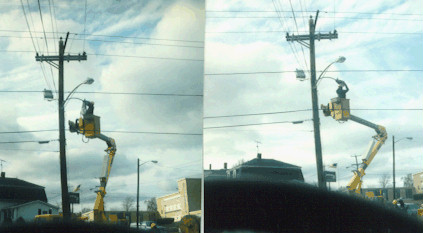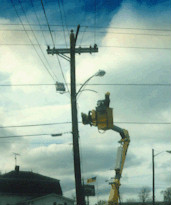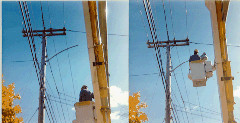

Line Materials Unistyle 175 watt Mercury Removal Nov. 1991


Line Materials Unistyle 175 watt Mercury Removal Nov. 1991
DUMPSTER DIVING
I visited Company A's facility religiously nearly every day on the way home from work, not knowing what treasure was there awaiting for me. Prior to my securing permission and visitations there I discovered an elderly, very energetic man in his late 70s also had consent to access the company's salvage area. The only things he collected were pieces of copper wire, brass and anything made of aluminum, of course. That especially meant streetlights. I quickly learned that a street light hunter's worst enemy is a junkman, especially when you had to share common ground and desires with one. The reality of the matter was that one man wanted to preserve these beloved fixtures that adorned the local communities for posterity while the other was eager to strip them down to their bare naked bones for a dollar or two each scrap value, only to be recycled probably into the next year's beer and soda cans, etc. At first it was difficult to rescue desired fixtures from him; he always got there before I did. It was a dreadful shame I missed out on a few nice lights, which I am sure he only got pocket change for. As he brutally and methodically took the fixtures apart at the utility's site, he stuffed the carnage worth selling into the trunk of his 1986 Lincoln Marquis sedan which could probably sleep three full sized adults. From there he sold his "gold" at the scrap yard the next day. It took a while before I established diplomatic relations with this gentleman, notably upon finally realizing I was a bona-fide street light collector and did not sell them. Trading pieces of copper and aluminum I picked up here and there also got him to put aside some good fixtures before I got there.
Company B's satellite headquarters I had been visiting for two years moved during early 1990 and I could no longer gain access to the newly fenced-in location they relocated to a few towns away. Later that year dumpster privileges were rescinded at Company A because their insurance company was appalled to hear of my and the elderly gentleman's regular dumpster expeditions through broken glass, sharp wire, cut poles, splintered crossarms and other potentially dangerous objects. We were nicely asked by one of their supervisors not to return; so the party was over. As sad as it was, I comforted and reassured myself by realizing that I had amassed a respectable fixture collection during the prior two and a half years of dedicated salvage efforts. Company A still had a lot of nice old lights still in service and I felt absolutely sure I would never own any of them.


Wheeler 100 w. "Acorn" Fixture removal, Oct. 1993
THE BIG HPS CONVERSION
That concept proved to be wrong. To my surprise during late 1990 Company A started a massive assault with HPS in a portion of their service area. I discovered this activity one day on the way home from work, startled by seeing strings of shiny new HPS fixtures along a couple main roads. Fortunately I made this discovery early in the game.
Initially this HPS campaign was conducted by an outside contractor. They knew of me and said they owned any lights they removed and I could purchase any from their scrap pile for salvage value. They were working on some primary roadways that had strings of 400-watt mercurys; some real neat stuff like early General Electric remote ballast lights and similar models with photocontrols mounted on them. A couple I got still had the late 1950s tube-powered photocontrols with glass covers. I made my way to their yard daily for several months right after work until their contract expired. The trick was that I had to beat their salvage man to the site. He had been contracted to disassemble and scrap the salable aluminum. Usually I was able to dodge him; however after several encounters I got him to cooperate, trading liquid refreshments of his favorite brand in exchange for the types of lights I said I wanted. I was fortunate to have acquired what I did from this resource, which supplemented my collection with some nice rarities. When the contractor's contract with Company A expired, they decided to have their own personnel conduct the remainder of the conversion which consisted of several thousand more lights.